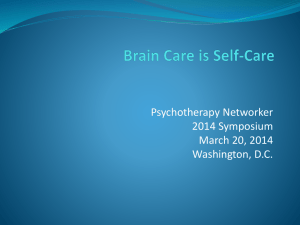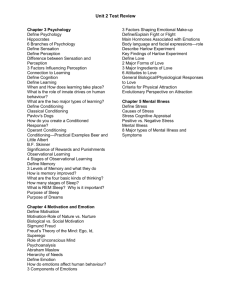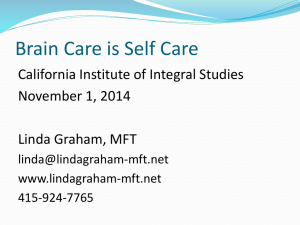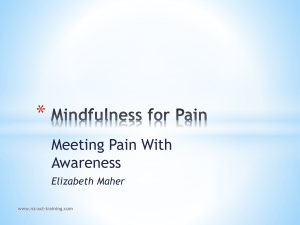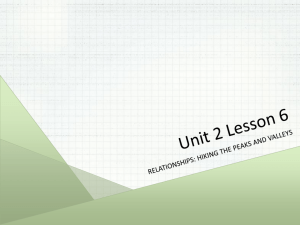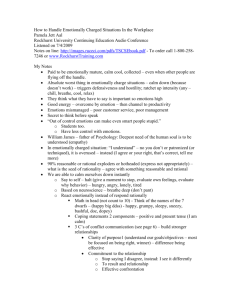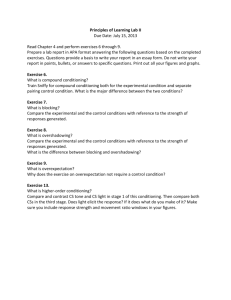presentation as PowerPoint slides
advertisement
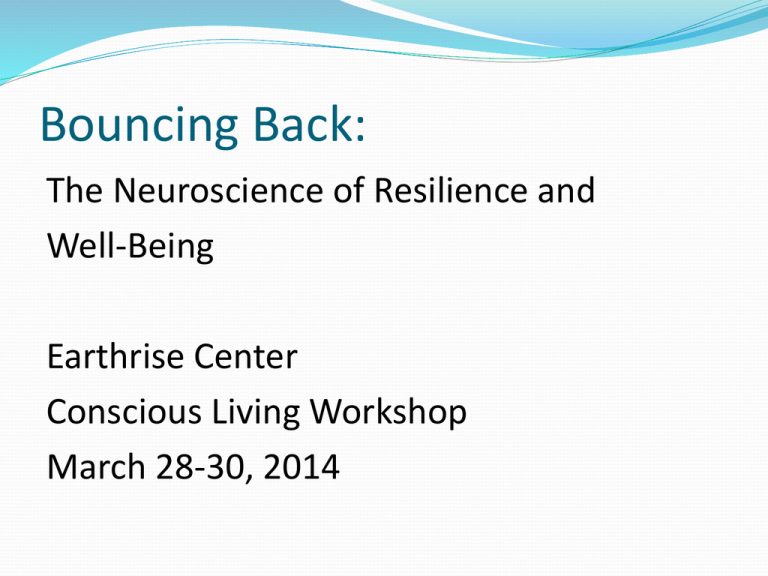
Bouncing Back: The Neuroscience of Resilience and Well-Being Earthrise Center Conscious Living Workshop March 28-30, 2014 Bouncing Back The Neuroscience of Resilience and Well-Being Linda Graham, MFT linda@lindagraham-mft.net www.lindagraham-mft.net 415-924-7765 All the world is full of suffering. It is also full of overcoming. - Helen Keller Resilience Deal with challenges and crises Bounce back from adversity Recover our balance and equilibrium Find refuges and maximize resources Cope skillfully, flexibly, adaptively Shift perspectives, open to possibilities, create options, find meaning and purpose 6 C’s of Coping Calm Compassion Clarity Connections to Resources Competence Courage Practices to Accelerate Brain Change Presence – primes receptivity of brain Intention/choice – activates plasticity Perseverance – creates and installs change Neuroscience of Resilience Neuroscience technology is 20 years old Meditation shifts mood and perspective; impacts immune system and gene expression Oxytocin can calm a panic attack in less than a minute Kindness and comfort, early on, protects against later stress, trauma, psychopathology Neuroplasticity Growing new neurons Strengthening synaptic connections Myelinating pathways – faster processing Creating and altering brain structure and circuitry Organizing and re-organizing functions of brain structures The brain is shaped by experience. And because we have a choice about what experiences we want to use to shape our brain, we have a responsibility to choose the experiences that will shape the brain toward the wise and the wholesome. - Richard J. Davidson, PhD The field of neuroscience is so new, we must be comfortable not only venturing into the unknown but into error. - Richard Mendius, M.D. Evolutionary legacy Genetic templates Family of origin conditioning Norms-expectations of culture-society Who we are and how we cope…. …is not our fault. Given neuroplasticity And choices of self-directed neuroplasticity Who we are and how we cope… …is our responsibility Conditioning Experience causes neurons to fire Repeated experiences, repeated neural firings Neurons that fire together wire together Strengthen synaptic connections Connections stabilize into neural pathways Conditioning is neutral, wires positive and negative Pre-Frontal Cortex Executive center of higher brain Evolved most recently – makes us human Development kindled in relationships Matures the latest – 25 years of age Evolutionary masterpiece CEO of resilience Functions of Pre-Frontal Cortex Regulate body and nervous system Quell fear response of amygdala Manage emotions Attunement – felt sense of feelings Empathy – making sense of expereince Insight and self-knowing Response flexibility Mechanisms of Brain Change Conditioning New Conditioning Re-Conditioning De-Conditioning New Conditioning Choose new experiences Positive emotions, resonant relationships, selfcompassion, self-acceptance Create new learning, new memory Encode new wiring Install new pattern of response Re-conditioning “Light up” neural networks Juxtapose old negative with new positive De-consolidation - re-consolidation New rewires old Modes of Processing Focused Tasks and details Self-referential New conditioning and re-conditioning De-focused Default network Mental play space De-conditioning De-Conditioning De-focusing Loosens grip Creates mental play space Plane of open possibilities New insights, new behaviors Keep Calm and Carry On Serenity is not freedom from the storm but peace amidst the storm. - author unknown Window of Tolerance SNS – explore, play, create, produce…. OR Fight-flight-freeze Baseline physiological equilibrium Calm and relaxed, engaged and alert WINDOW OF TOLERANCE Relational and resilient Equanimity PNS – inner peace, serenity…. OR Numb out, collapse Hand on the Heart Touch Deep breathing Positive Emotions Brakes on survival responses Oxytocin – safety and trust Relationships as resources Oxytocin Hormone of safety and trust, bonding and belonging, calm and connect Brain’s direct and immediate antidote to stress hormone cortisol Can pre-empt stress response altogether Calm through the Body Hand on the Heart Body Scan Progressive Muscle Relaxation Movement Opposite Calm – Friendly Body Scan Awareness Breathing gently into tension Hello! and gratitude Release tension, reduce trauma Progressive Muscle Relaxation Body cannot be tense and relaxed at the same time Tense for 7 seconds, relax for 15 Focused attention calms the mind Calm through Movement Body inhabits posture of difficult emotion (40 seconds Body moves into opposite posture (40 seconds) Body returns to first posture (20 seconds) Body returns to second posture (20 seconds) Body finds posture in the middle (30 seconds Reflect on experience Breathing for Two - Equanimity Partner A lies comfortably on the floor; closes eyes Partner B sits near enough to place one hand on partner A’s hand, the other on the crown of partner A’s head Partner A breathes normally, peacefully Partner B synchronizes his/her breathing with partner After three minutes, switch roles Reflect on experience Mindfulness and Empathy Awareness of what’s happening (and our reactions to what’s happening) Acceptance of what’s happening (and our reactions to what’s happening) Two most powerful agents of brain change known to science Mindfulness Comes to West Mindfulness: Focused attention on present moment experience without judgment or resistance. - Jon Kabat-Zinn Attention and allowing Awareness and acceptance Mindfulness Pause, become present Notice and name Step back, dis-entangle, reflect Catch the moment; make a choice Shift perspectives; shift states Discern options Choose wisely – let go of unwholesome, cultivate wholesome Notice and Name Thoughts as thoughts Patterns of thoughts as patterns of thoughts Cascades of emotions as cascades of emotions States of mind as states of mind Belief systems and identities as… Mental contents, patterns of neural firing Between a stimulus and a response there is a space. In that space is our power to choose our response. In our response lies our growth and our freedom. The last of human freedoms is to choose one’s attitude in any given set of circumstances. - Viktor Frankl, Austrian psychiatrist, survivor of Auschwitz Autobiography in Five Short Chapters – Portia Nelson I I walk down the street. There is a deep hole in the sidewalk I fall in. I am lost…I am helpless It isn’t my fault. It takes me forever to find a way out. II I walk down the same street. There is a deep hole in the sidewalk. I pretend I don’t see it. I fall in again. I can’t believe I’m in the same place But, it isn’t my fault. It still takes a long time to get out. III I walk down the same street. There is a deep hole in the sidewalk. I see it is there. I still fall in…it’s a habit My eyes are open, I know where I am. It is my fault. I get out immediately. IV I walk down the same street There is a deep hole in the sidewalk. I walk around it. V I walk down another street. -Portia Nelson Resonance Circuit Resonance – vibe, emotional contagion Attunement – felt sense, explicit, non-verbal Empathy – verbal, cognitive, coherent narrative Compassion – concern, caring, help Acceptance – pre-requisite for resilience and lasting change The curious paradox is that when I accept myself just as I am, then I can change. - Carl Rogers Integration Reflection See clearly Resonance Embrace wholeheartedly Kindness is more important than wisdom, And the recognition of that is the beginning of wisdom. - Theodore Rubin Neuroscience of Empathy Emotional communication is 93% non-verbal Social engagement system – vagal brake Dyadic regulation Vagal brake Fusiform gyrus regulates amygdala Restores equilibrium Compassion Respond to pain or suffering with an open heart, an interested mind, and a natural willingness to help. Open to experience, activate care-giving, prime ourselves to act “Left shift” in brain – more neural activity in left hemisphere – approach stance toward experience Overcome negativity bias; become more optimistic, more flexible, better resources, better able to find solutions Self-Compassion Threat-protection system Cortisol driven Pleasure-reward system Dopamine driven Caregiving-soothing-comfort system Oxytocin driven Paul Gilbert, The Compassionate Mind Self-Compassion Notice this is a moment of suffering “Ouch! This hurts.” What would be comforting here? What would be helpful? Open to larger perspective “My” pain is “the” pain I’m not the only one; I’m not alone Mindful Self-Compassion Awareness of what’s happening (and our reaction to what’s happening) Acceptance of what’s happening (and acceptance of our reaction) Brain stays plastic, open to learning The Guest House - Rumi This being human is a guest-house. Every morning a new arrival. A joy, a depression, a meanness, Some momentary awareness come As an unexpected visitor. Welcome and entertain them all! Even if they’re a crowd of sorrows, who violently sweep your house empty of its furniture, still, treat each guest honorably. He may be clearing you out for some new delight. The dark thought, the shame, the malice, meet them at the door laughing, and invite them in. Be grateful for whoever comes, because each has been sent as a guide from beyond. - Rumi Self-Compassion Break Notice-recognize: this is a moment of suffering Ouch! This hurts! This is hard! Pause, breathe, hand on heart or cheek Oh sweetheart! Self-empathy Of course this is painful, and I’m not the only one; I’m not alone Drop into calm; hold moment with awareness; breathe in compassion and care May I be free of suffering and the causes of suffering Share experience with resonant other Seeing Ourselves as Others See Us Imagine sitting across from someone who loves you unconditionally Imagine switching places with them; see yourself as they see you; feel why they love you and delight in you; take in the good Imagine being yourself again; taking in the love and affection coming to you; savor and absorb. Deep Listening The most basic and powerful way to connect to another person is to listen. Just listen. Perhaps the most important thing we ever give each other is our attention….A loving silence often has far more power to heal and to connect than the most well-intentioned words. - Rachel Naomi Remen, M.D. Deep Listening Listener asks speaker the question. Speaker answers honestly. The speaker answers the repeating question for several rounds, deepening his/her understanding of his/her experience. Listener and speaker switch roles. Take a few moments to share reflections on the experience. Questions for Deep Listening What brings you joy in your life? What has brought you sorrow? What worries you now? When have you found courage in dark times? What are you grateful for? What are you proud of? Clarity It is not the strongest of the species that survives, nor the most intelligent. It is the one that is the most adaptive to change. - Charles Darwin Every moment brings a choice, and every choice has an impact. Julia Butterfly Hill Mindfulness of Patterns Thoughts as thoughts Patterns of thoughts as patterns of thoughts Cascades of emotions as cascades of emotions States of mind as states of mind Belief systems and identities as… Mental contents, patterns of neural firing Cues to Practice - ANTS to PATS Identify habitual negative pattern of response Identify new, positive response to counter/replace Identify cue word or phrase to break automaticity and change the channel Practice using the old pattern as a cue to use the cue word or phrase to trigger the new pattern. Repeat the practice as many times as necessary Modes of Processing Focused Tasks and details Self-referential New conditioning and re-conditioning De-focused Default network Mental play space De-conditioning Mindfulness Dissolves the Stuff of “Self” Quantum physics investigates matter Matter is more space than stuff Mindfulness investigates “I” Self is not static or fixed; is ever-changing, ever-unfolding True Self is flow of beingness Rest in Simply Being Awareness of Awareness Insights, epiphanies, revelations Wisdom teaches me I am nothing. Love teaches me I am everything. Between the two, my life flows. - Sri Nisargadatta Pre-frontal cortex toggles Deeper brain integration Consciousness True Nature Wiser Self Adult Self Inner Child Brahma Viharas Loving Kindness Compassion Sympathetic Joy Equanimity Connections to Resources People Love guards the heart from the abyss. - Mozart Places …I rest in the grace of the world…. – Berry Practices As an irrigator guides water to his field, as an archer aims an arrow, as a carpenter carves wood, the wise shape their lives. - Buddha Positive Emotions-Behaviors Brain hard-wired to notice and remember negative and intense more than positive and subtle; how we survive as individuals and as a species Leads to tendency to avoid experience Positive emotions activate “left shift,” brain is more open to approaching experience, learning, and action Positive Emotions Gratitude Awe Generosity Compassion Delight Serenity Love Curiosity Kindness Joy Trust Positive Emotions Less stress, anxiety, depression, loneliness More friendships, social support, collaboration Shift in perspectives, more optimism More creativity, productivity Better health, better sleep Live on average 7-9 years longer Gratitude 2-minute free write Gratitude journal Gratitude buddy Carry love and appreciation in your wallet Positivity Portfolio Ask 10 friends to send cards or e-mails expressing appreciation of you Assemble phrases on piece of paper Tape to bathroom mirror or computer monitor, carry in wallet or purse Read phrases 3 times a day for 30 days Savor and appreciate Take in the Good Notice: in the moment or in memory Enrich: the intensity, duration, novelty, personal relevance, multi-modality Absorb: savor 10-20-30 seconds, felt sense in body The Peace of Wild Things When despair for the world grows in me and I wake in the night at the least sound in fear of what my life and my children’s lives may be, I go and lie down where the wood drake rests in his beauty on the water, and the great heron feeds. I come into the peace of wild things who do not tax their lives with forethought of grief. I come into the presence of still water. And I feel above me the day-blind stars waiting with their light. For a time I rest in the grace of the world, and am free. - Wendell Berry One summer night, out on a flat headland, all but surrounded by the waters of the bay, the horizons were remote and distant rims on the edge of space. Millions of stars blazed in darkness, and on the far shore a few lights burned in cottages. Otherwise there was no reminder of human life. My companion and I were alone with the stars: the misty river of the Milky Way flowing across the sky, the patterns of the constellations standing out bright and clear, a blazing planet low on the horizon. It occurred to me that if this were a sight that could be seen only once in a century, this little headland would be thronged with spectators. But it can be seen many scores of night in any year, and so the lights burned in the cottages and the inhabitants probably gave not a thought to the beauty overhead; and because they could see it almost any night, perhaps they never will. - Rachel Carson Places as Resources Nature as refuge – re-Source Nature is our biology, our being We can create and notice shifts in perspective Shifting Perspectives in Nature BELLY BOTANY Find a one square foot patch of earth. Observe for two minutes. (light and shadow, movement and stillness, beauty and decay, life and death) Shift your view to the larger landscape, all the way to the horizon. Reflect on shift in perspective. People as Resources At times our own light goes out and is rekindled by the spark from another person. Each of us has cause to think with deep gratitude of those who have lighted the flame within us. - Albert Schweitzer The roots of resilience are to be found in the felt sense of being held in the heart and mind of an empathic, attuned, and self-possessed other. - Diana Fosha, PhD Attachment Styles - Secure Parenting is attuned, empathic, responsive, comforting, soothing, helpful Attachment develops safety and trust, and inner secure base Stable and flexible focus and functioning Open to learning inner secure base provides buffer against stress, trauma, and psychopathology Insecure-Avoidant Parenting is indifferent, neglectful, or critical, rejecting Attachment is compulsively self-reliant Stable, but not flexible Focus on self or world, not others or emotions Rigid, defensive, not open to learning Neural cement Insecure-Anxious Parenting is inconsistent, unpredictable Attachment is compulsive caregiving Flexible, but not stable Focus on other, not on self-world, Less able to retain learning Neural swamp Disorganized Parenting is frightening or abusive, or parent is “checked out,” not “there” Attachment is fright without solution Lack of focus Moments of dissociation Compartmentalization of trauma Coherent Narrative This is what happened. This is what I did. This has been the cost. This is what I learned. This is what I would do differently going forward. Ah, the comfort, The inexpressible comfort Of feeling safe with a person. Having neither to weigh out thoughts Nor words, But pouring them all right out, just as they are, Chaff and grain together; Certain that a faithful hand Will take them and sift them; Keeping what is worth keeping and, With the breath of kindness, Blow the rest away. - Dinah Craik Welcome Them All Wiser Self welcomes to the “party” characters that embody positive and negative parts of the self with curiosity and acceptance of the message or gift of each part and honors each part of the “inner committee” Shame De-Rails Resilience Shame is the intensely painful feeling or experience of believing we are flawed and therefore unworthy of acceptance and belonging. Shame erodes the part of ourselves that believes we are capable of change. We cannot change and grow when we are in shame, and we can’t use shame to change ourselves or others. - Brene Brown, PhD Love makes your soul crawl out of its hiding place. - Zora Neale Hurston Love guards the heart from the abyss. - Mozart Just that action of paying attention to ourselves, that I care enough about myself, that I am worthy enough to pay attention to, starts to unlock some of those deep beliefs of unworthiness at a deeper level in the brain. - Elisha Goldstein Reconditioning Memory de-consolidation – re-consolidation “Light up” neural networks of problematic memory Cause neural networks to fall apart temporarily and instantly rewire by: Juxtaposing positive memory that directly contradicts or disconfirms; Focused attention on juxtaposition of both memories held in simultaneous dual awareness Causes the falling apart and the rewiring Reconditioning Anchor in present moment awareness Resource with acceptance and goodness Start with small negative memory “Light up the networks” Evoke positive memory that contradicts or disconfirms Simultaneous dual awareness (or toggle) Refresh and strengthen positive Let go of negative Rest in, savor positive Reflect on shifts in perspective Wished for Outcome Evoke memory of what did happen Imagine new behaviors, new players, new resolution Hold new outcome in awareness, strengthening and refreshing Notice shift in perspective of experience, of self Relational Intelligence Setting limits and boundaries Negotiating change Resolving conflicts Repairing ruptures Forgiveness Forgiveness - I For the many ways that I have hurt and harmed myself, that I have betrayed or abandoned myself, out of fear, pain, and confusion, through action or inaction, in thought, word or deed, knowingly or unknowingly… I extend a full and heartfelt forgiveness. I forgive myself. I forgive myself. Forgiveness - II For the ways that I have hurt and harmed you, have betrayed or abandoned you, caused you suffering, knowingly or unknowingly, out of my pain, fear, anger, and confusion… I ask for your forgiveness, I ask for your forgiveness. Forgiveness - III For the many ways that others have hurt, wounded, or harmed me, out of fear, pain, confusion, and anger… I have carried this pain in my heart long enough. To the extent that I am ready, I offer you forgiveness. To those who have caused me harm, I offer my forgiveness, I forgive you. Human Brain: Evolutionary Masterpiece 100 billion neurons Each neuron contains the entire human genome Neurons “fire” hundreds of time per second Neurons connect to 5,000-7,000 other neurons Trillions of synaptic connections As many connections in single cubic centimeter of brain tissue as stars in Milky Way galaxy Brain Care Is Self Care Sleep Nutrition Movement-Exercise Laughter Hanging Out with Healthy Brains Sleep Housekeeping Reset nervous system Consolidate learning Take mental breaks How to Sleep Well Stick to a sleep schedule Pay attention to what you eat and drink Create a bedtime ritual Get comfortable Limit daytime naps Include physical activity in your daily routine Manage stress - Mayo Clinic Take Mental Breaks Focus on something else (positive is good) Talk to someone else (resonant is good) Move-walk somewhere else (nature is good) Avoid adrenal fatigue Nutrition Less Caffeine Less Sugar More Protein Movement - Exercise Oxygen – brain is 2% of body weight, uses 20% of body’s oxygen Endorphins – feel good hormones, brighten the mind Brain-Derived Neurotrophic Factor (BDNF) grow new brain cells, will migrate to where needed Laughter Increases oxygen and blood flow, reduces risk of heart disease and stroke Releases endorphins – body’s natural pain killer Reduces stress hormone cortisol, lowers blood pressure Triggers catecholamines, heightens alertness in brain Releases tension in body, balances nervous system Laughter Promotes work productivity Reduces stress Promotes creativity and problem-solving Reduces mistakes, increases efficiency Promotes group cohesion Promotes learning (through play) Eases loss, grief, trauma How to Promote Laughter Humor A person without a sense of humor is like a wagon without springs – jolted by every pebble in the road. - Henry Ward Beecher Play Play, in short, prepares the brain to handle the unexpected. – Lee Alan Dugatkin Playful resonance Laughter is the closest distance between two people. – Victor Borge Hanging Out with Healthy Brains Brain is social organ; matures and learns best in interactions with other brains Social engagement regulates nervous system Resonant interactions prime the brain’s neuroplasticity; promotes learning and growth Practices to Accelerate Brain Change Presence – primes receptivity of brain Intention/choice – activates plasticity Perseverance – creates and installs change Presence To be present is far from trivial. It may be the hardest work in the world. And forget abou the “may be.” It is the hardest work in the world – at least to sustain presence. And the most important. - Jon Kabat-Zinn Intention And the day came when the risk it took To stay tight inside the bud Was more painful than the risk it took to blossom. - Anais Nin Perseverance How long should you try? Until. - Jim Rohn The difference between try and triumph is a little “umph.” – author unknown The greatest oak was once a little nut that held its ground. – Author unknown How to Create a New Habit Identify new behavior you want to cultivate Identify reward for new behavior; how will you sense that reward in your body? Identify first five seconds of new behavior Identify cue to begin the first five seconds of behavior Competence Bodily felt sense of “Sure I can!” Based on previous competence No matter what, no matter how small Ownership Learning Model Unconscious Incompetence Conscious Incompetence Conscious Competence Unconscious Competence Coherent Narrative This is what happened. This is what I did. This has been the cost. This is what I learned. This is what I would do differently going forward. Find the Gift in the Mistake Regrettable Moment – Teachable Moment What’s Right with this Wrong? What’s the Lesson? What’s the Cue to Act Differently? Find the Gift in the Mistake Courage It’s as wrong to deny the possible As it is to deny the problem. - Dennis Seleeby Courage A ship is safe in harbor, but that’s not what ships are for. - Grace Hopper Yes, risk-taking is inherently failure-prone. Otherwise, it would be called sure thing-taking - Tim McMahon Do One Scary Thing a Day Venture into New or Unknown Somatic marker of “Uh, oh” Dopamine disrupted Cross threshold into new Satisfaction, mastery Dopamine restored I am no longer afraid of storms, For I am learning how to sail my ship. - Louisa May Alcott Mechanisms of Brain Change Conditioning New Conditioning Re-Conditioning De-Conditioning Modes of Processing Focused Tasks and details Self-referential New conditioning and re-conditioning De-focused Default network Mental play space De-conditioning Practices to Accelerate Brain Change Presence – primes receptivity of brain Intention/choice – activates plasticity Perseverance – creates and installs change Bouncing Back The Neuroscience of Resilience and Well-Being Linda Graham, MFT linda@lindagraham-mft.net www.lindagraham-mft.net 415-924-7765
